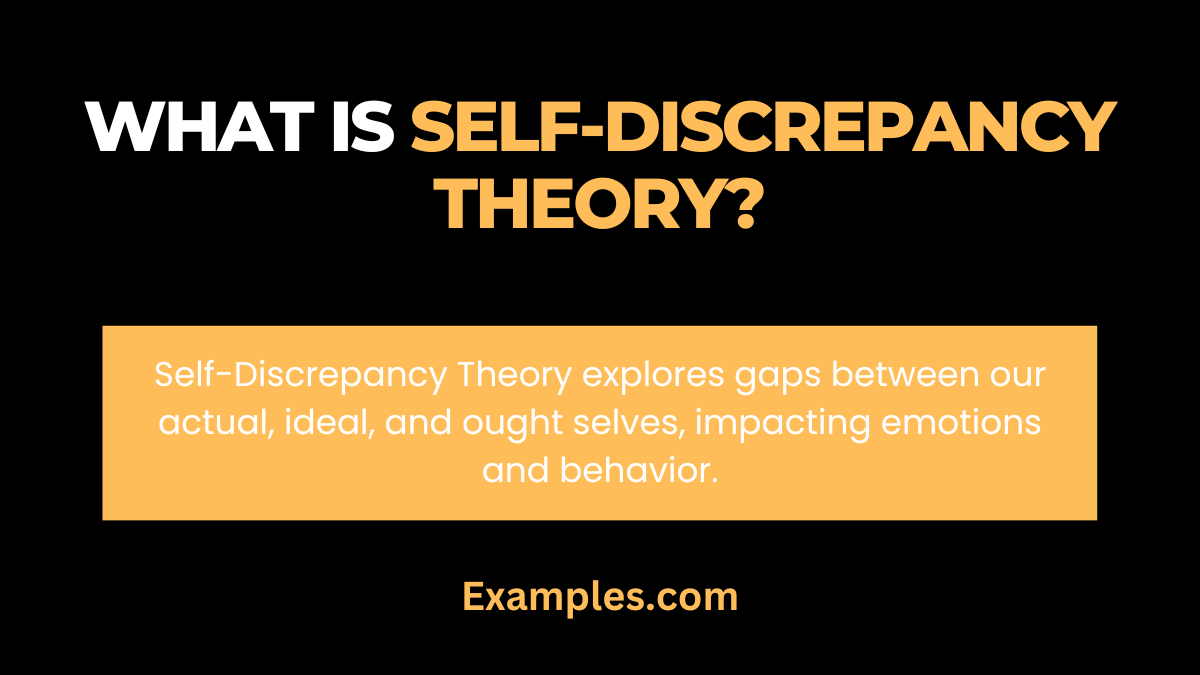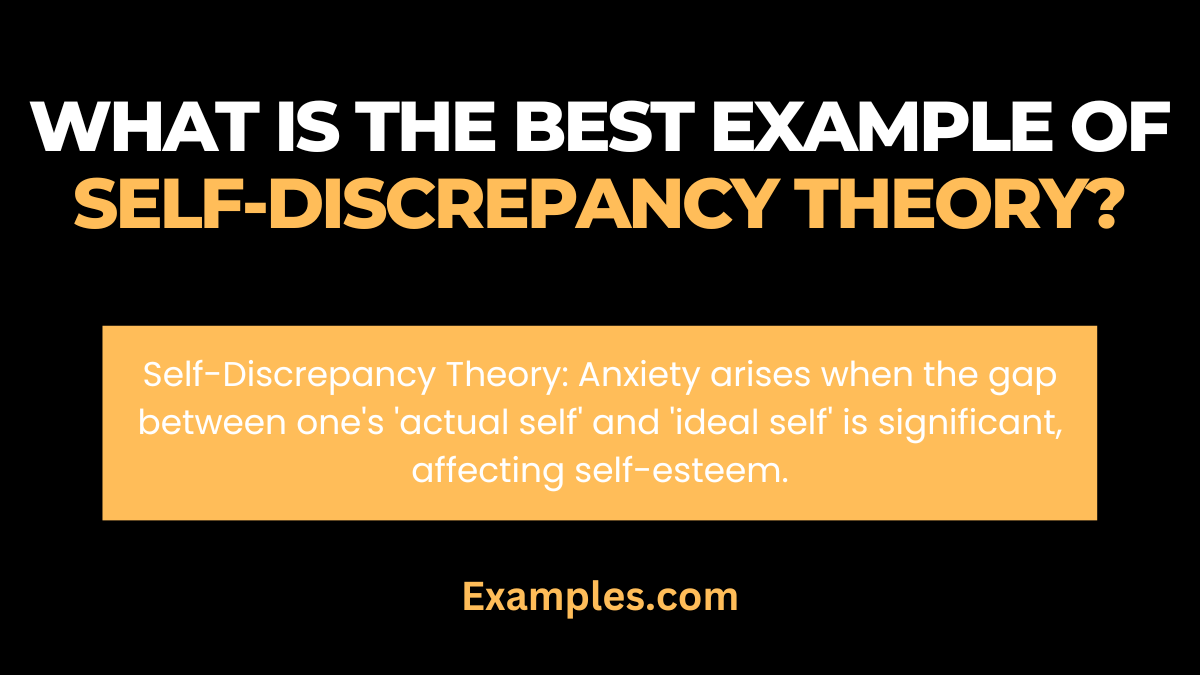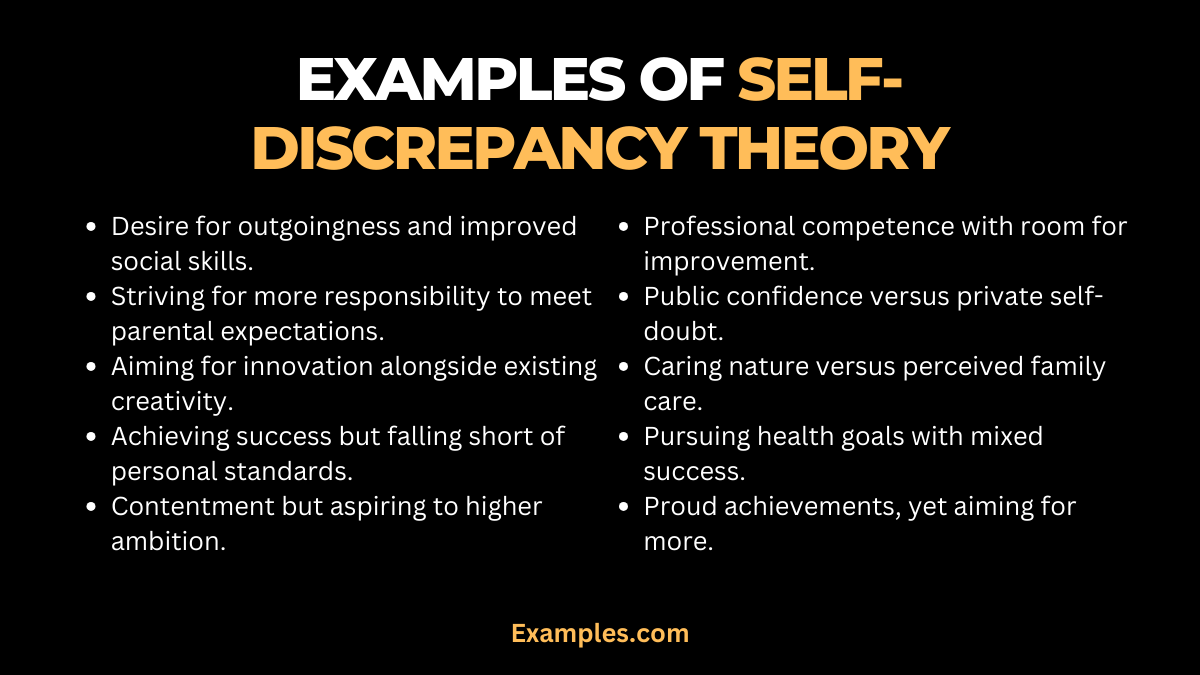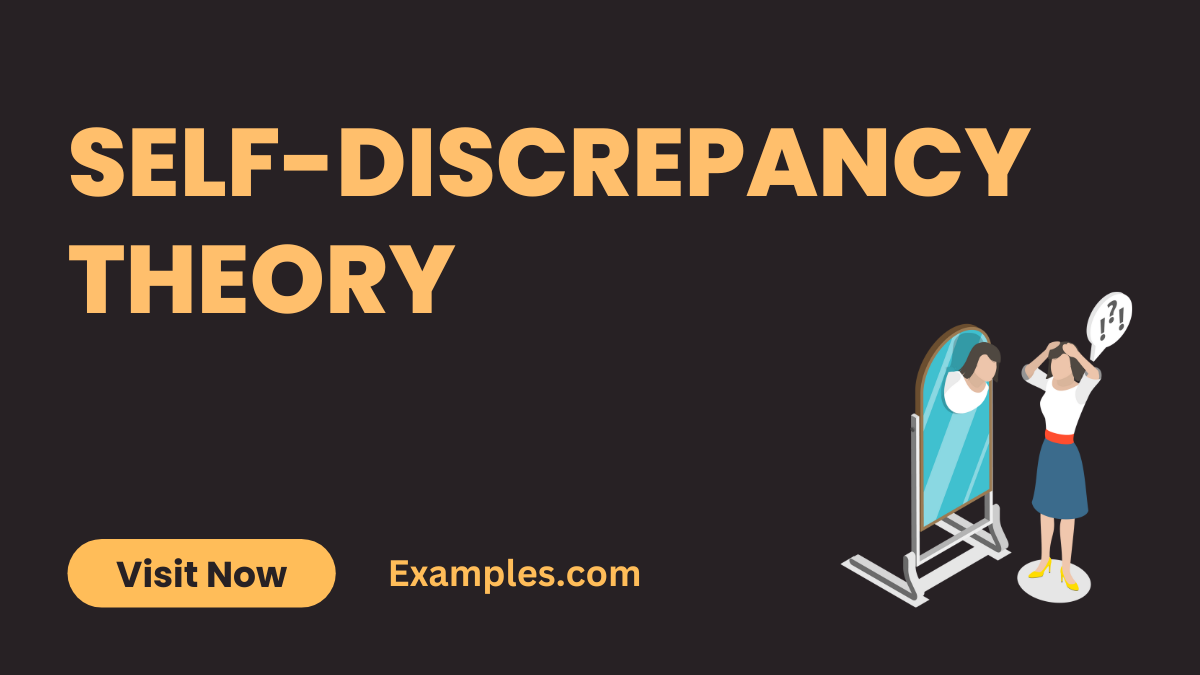19+ Self-Discrepancy Theory Examples
Self-Discrepancy Theory is a fascinating concept in intrapersonal communication that explores the gap between our ‘actual self’ and ‘ideal self.’ This theory helps us understand why we feel content or dissatisfied with ourselves. It is crucial in personal development, aiding in setting realistic goals and improving self-esteem. By comparing our current state with our aspirations or the standards set by others, we gain valuable insights into our inner world, guiding us towards more fulfilling and authentic lives.
What is Self-Discrepancy Theory?

Self-Discrepancy Theory, a concept in intrapersonal communication theories, delves into the differences between our ‘actual self’ (who we are now), ‘ideal self’ (who we wish to be), and ‘ought self’ (who others think we should be). It explains how these discrepancies affect our emotions, motivation, and behavior, offering a framework for understanding and managing personal expectations and societal pressures.
History
Who Created: Higgins
Date: 1987
The Self-Discrepancy Theory, a significant concept in intrapersonal communication, was developed by psychologist Higgins in 1987. This theory delves into the understanding of one’s self-perception and the emotional effects caused by discrepancies between different self-states: the actual self (how one sees themselves), the ideal self (how one wishes to be), and the ought self (how one ought to be).
What is the Best Example of Self-Discrepancy Theory?

The best example of Self-Discrepancy Theory is when an individual experiences anxiety or low self-esteem due to a significant gap between their ‘actual self’ and ‘ideal self.’ For instance, a young professional might feel inadequate because their current achievements don’t match their personal aspirations or the expectations of their peers and family. This discrepancy can lead to feelings of failure and a persistent sense of not being good enough, highlighting the theory’s relevance in understanding emotional responses to self-perception.
20 Examples of Self-Discrepancy Theory

Self-Discrepancy Theory delves into the psychological realm, examining the differences between one’s actual self, ideal self, and ought self. This theory, integral in intrapersonal communication, highlights how these discrepancies impact emotions, self-esteem, and motivation. Understanding this theory is crucial for personal development, enhancing intrapersonal communication skills, and achieving self-alignment. It’s a key concept in psychology, relevant in counseling, personal growth, and understanding human behavior.
- “I am not as outgoing as I wish to be. I need to work on my social skills.”
Recognizing the gap between actual self and ideal social self. - “My parents expect me to be more responsible. I should start planning better.”
Identifying the difference between actual self and the ought self as seen by significant others. - “I see myself as creative, yet I want to be more innovative in my work.”
Acknowledging the discrepancy between current creativity and the desired level. - “I am successful, but I still feel like I’m not meeting my own standards.”
Feeling the gap between one’s achievements and their own ideal standards. - “I often feel anxious because I’m not as assertive as I think I should be.”
Experiencing emotional distress due to a gap between actual and ought self in assertiveness. - “I am content with my life, yet I sometimes feel I’m not ambitious enough.”
Comparing one’s actual contentment with the ideal ambition they wish to possess. - “I’m good at my job, but I constantly feel I could do better.”
The disparity between one’s professional competence and their ideal professional self. - “People see me as confident, but internally, I often struggle with self-doubt.”
Contrast between public perception and private self-perception. - “I’m a caring person, but sometimes I feel I don’t care enough for my family.”
The difference between one’s actual caring nature and their ideal caring self. - “I strive to be healthy, yet I often fail to meet my health goals.”
Recognizing the gap between current health habits and ideal health goals. - “I value honesty, but find myself not being as transparent as I should be.”
The conflict between one’s values of honesty and their actual communication practices. - “I’m usually calm, but I aspire to handle stress with even more composure.”
The desire to bridge the gap between current and ideal stress management skills. - “I see myself as a good listener, yet sometimes I feel I don’t listen enough.”
Acknowledging the difference between perceived and ideal listening skills. - “I am independent, but sometimes feel pressured to conform to others’ expectations.”
Struggling with the tension between personal independence and societal expectations. - “I enjoy learning, but feel I’m not as knowledgeable as I want to be.”
The disparity between one’s current knowledge and their ideal level of understanding. - “I consider myself friendly, but often feel I’m not as sociable as others expect.”
Recognizing the difference between actual sociability and perceived social expectations. - “I am proud of my achievements, yet I always think I could achieve more.”
The ongoing pursuit to bridge the gap between current accomplishments and ideal aspirations. - “I’m seen as reliable, but internally, I question my consistency.”
Internal conflict between public reliability and personal doubts about consistency. - “I value being open-minded, but sometimes find it hard to accept new ideas.”
Confronting the difference between the value of open-mindedness and actual receptiveness. - “I am generally happy, but sometimes I feel I should be more fulfilled.”
The emotional gap between one’s actual state of happiness and their ideal sense of fulfillment.
Assumptions of Self-Discrepancy Theory
Self-Discrepancy Theory, a significant concept in Intrapersonal Communication Theories, posits that individuals compare their “actual” self (attributes they believe they possess) with their internalized standards or “desired” selves. These comparisons are of two types: “ideal self” (what they aspire to be) and “ought self” (what they think they should be). This theory assumes:
- Existence of Multiple Selves: People possess various self-states, including actual, ideal, and ought selves.
- Impact of Discrepancies: Discrepancies between these selves can lead to emotional discomfort, influencing behavior and self-perception.
- Guiding Behavior and Emotions: The theory suggests that reducing these discrepancies motivates behavior, aiming for a state of congruence.
- Different Affects Result from Different Discrepancies: Discrepancies between the actual and ideal selves often lead to feelings of dejection, such as disappointment, while discrepancies between the actual and ought selves can cause agitation, like anxiety.
- Role of Significant Others: The ideals and ought standards are largely influenced by the expectations and values of significant others in one’s life.
- Cognitive Awareness: Individuals are generally aware of these discrepancies, which form part of their Intrapersonal Communication Activities.
- Cultural Variations: The nature and impact of these discrepancies can vary across different cultures.
- Influence on Self-Regulation: The theory is instrumental in understanding self-regulation processes, guiding how individuals control and direct their own actions.
Self-Discrepancy Theory Framework
The framework of Self-Discrepancy Theory provides a structure for understanding internal conflicts and emotional states within the context of Intrapersonal Communication. It comprises:
- Three Domains of the Self: The ‘Actual Self’ (self-concept), ‘Ideal Self’ (hopes and aspirations), and ‘Ought Self’ (sense of duty and obligation).
- Domains of Comparison: The comparison between these selves occurs in two domains – the ‘Ideal’ and the ‘Ought’.
- Regulatory Focus Theory: This associated theory suggests that people are motivated either by a promotion focus (achieving positive outcomes) or a prevention focus (avoiding negative outcomes), influenced by the type of self-discrepancy.
- Emotional Outcomes: Depending on the discrepancy, individuals may experience different emotional responses. Discrepancy with the ideal self leads to dejection-related emotions, while discrepancy with the ought self leads to agitation-related emotions.
- Impact on Behavior: The theory helps explain various behaviors, including the pursuit of goals, avoidance of certain situations, and reaction to failure.
- Self-Evaluation: It provides a basis for understanding how individuals evaluate themselves, impacting self-esteem and self-efficacy.
- Counseling and Therapy: The framework is useful in therapeutic settings, helping individuals understand and reconcile their self-discrepancies.
- Adaptability and Growth: It highlights the potential for personal growth and adaptability by understanding and managing these internal conflicts.
Self-Discrepancy Theory offers a profound understanding of how our self-perceptions shape our emotions and behaviors. By analyzing the gaps between our actual, ideal, and ought selves, this theory highlights the significance of intrapersonal communication in personal development. Understanding and applying the concepts of Self-Discrepancy Theory can lead to better intrapersonal communication skills, enhancing personal growth and emotional well-being.



